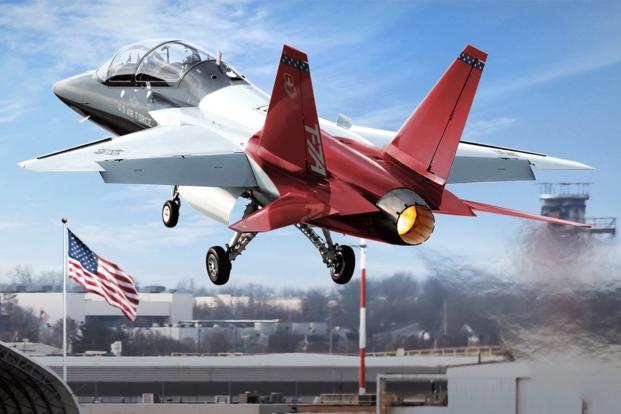The Air Force is asking for a delay in funding over its brand-new T-7A Red Hawk trainer as it works through a technical issue that has pushed its development by at least a year.
During a House Armed Services Committee hearing on the fiscal 2022 budget, Air Force Chief of Staff Gen. Charles "CQ" Brown said technical issues have pushed back the plane's "Milestone C," a review that happens before a program can enter the full production phase.
The Air Force had planned to ask for $206 million next year for research and development on T-7, but will ask for just $189 million instead. Advance timetables show the Red Hawk is being delayed roughly 15 months from the original "Milestone C" decision date.
Read Next: She Was a Pioneering Navy Submarine Officer. Now She's Headed to Space
"Our focus and commitment to the T-7 has not waned," Brown said Wednesday during the hearing. "We want to make sure the money aligns with where the program is."
The Air Force on Friday cited parts shortages -- due to COVID-19's effect on the global supply chain -- initial design delays, and additional required testing for the setback. The decision is now expected in late 2023.
"The T-7 Advanced Pilot Training program has inherent schedule risk because of the aggressive nature of the program's schedule," the service said in an email. The additional testing, the service said, has to do with the aircraft's wing rock, meaning the aircraft has the potential to enter an uncontrollable roll while flying at certain angles of attack.
The Air Force said the issue was discovered during the testing phase -- much earlier than in the traditional operational test and evaluation phase -- because of the T-7's early prototyping and digital engineering process.
The T-7 is manufactured using digital engineering, giving developers the ability to design and change blueprints with more flexibility as they create armaments or tools.
"The wing rock issue will be resolved via a flight software update that will correct for this phenomenon," officials said.
The initial design delays were due to a problem with contracting suppliers. "Digital model-based engineering would not have alleviated these concerns," the service said.
Boeing said the wing rock issue will not affect the integrity or design of the jet, said Deborah VanNierop, a company spokeswoman.
"Having the production relevant jets before Engineering & Manufacturing and Development (EMD) is a first and has allowed early learning which provides us the benefit of identifying issues early and reducing risk," VanNierop said in an email. "We have flown 246 EMD test flights to date, with flight test sortie rates significantly higher than in traditional test programs, and continue to achieve revolutionary aircraft build times."
She added, "New software is already loaded into the aircraft [and is] being prepped for the start of phase two testing. We will be validating the software into July."
Despite the Air Force’s time projection, Boeing expects the delay will be seven months, the company told Military.com.
In September 2018, the Air Force awarded Boeing Co. a $9.2 billion contract to build a replacement aircraft, with a working name of T-X. In 2019, the service rebranded the T-X as the T-7A Red Hawk, named in honor of the Tuskegee Airmen. The T-7 is built in partnership with Sweden's Saab.
The Air Force has committed to buying 351 T-7A jets, 46 simulators and associated ground equipment.
The development delay has some families worried about the continued use of the Northrop Grumman-made T-38 Talon, some of which date to the mid-1960s.
The service has seen a number of accidents in the aircraft over the last five years, some of them fatal.
"The T-38 is the only Air Force training jet for the fighter path so these men and women have no choice but to climb into these antiquated cockpits daily," Don and Carlene Wilkie told Military.com via email.
Their son, 2nd Lt. Travis Wilkie, died in 2019 while attempting to execute a formation landing alongside another jet at Vance Air Force Base, Oklahoma. The second lieutenant, and his instructor pilot, Lt. Col. John "Matt" Kincade, were killed in the crash. Following the release of the investigation into the accident, all the Wilkies saw was that the pilots had been saddled with the blame. But because of the crash, the service suspended formation landings indefinitely.
Still, the family questions why it will take years to replace the Air Education and Training Command's principal training aircraft, and fear more accidents in the aging jet will claim more lives. Despite the age of the trainer fleet, the Air Force has said there is no reason for concern.
"Bringing on the successor to the T-38 is important," Maj. Gen. Craig Wills, 19th Air Force commander, said last year. "But it's no question that we're maintaining [the T-38] exceptionally well and that we're committed to maintaining a safe fleet of airplanes [until that happens]," Wills said in an interview. "If I didn't think the fleet was safe, we wouldn't be flying."
"Just because we don't have a replacement isn't enough reason to keep flying a 60-year-old deathtrap," the Wilkies said. "To us, it's a ticking time bomb."
-- Oriana Pawlyk can be reached at oriana.pawlyk@military.com. Follow her on Twitter at @Oriana0214.
Related: F-16 Pilot's Runway Death Forces Reckoning Over Tight Flight Hours, Training Gaps












